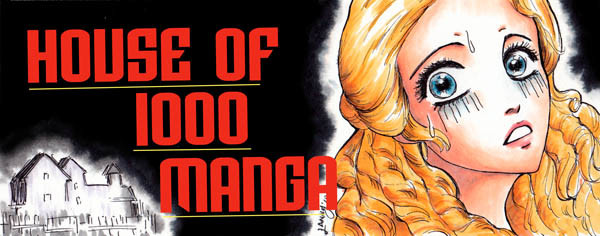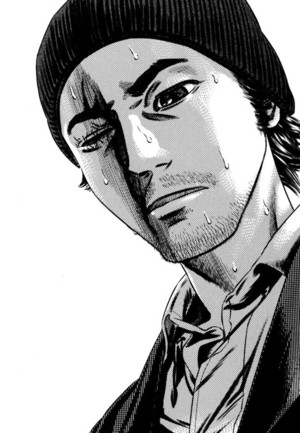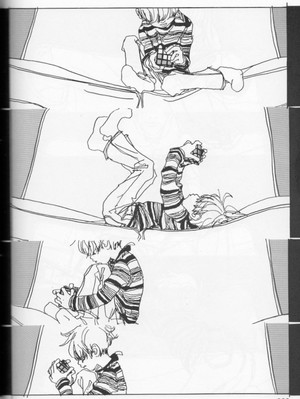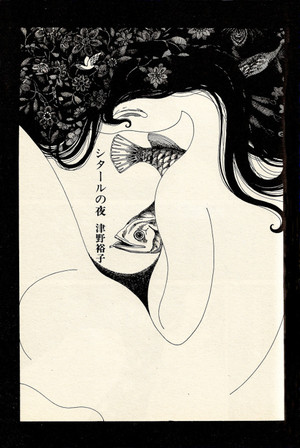House of 1000 Manga
Five Amazing Untranslated Manga
by Shaenon Garrity,

Five Amazing Untranslated Manga
When I tell people I work as a manga editor, one of the first and most reasonable questions I get is, “Oh, you read Japanese?” Sadly, no. All I bring to the job are my Seven Sisters-honed writing skills, my expertise in the comics medium, and my stubborn love of Oxford commas. Like that one. Look at it! Look how cute!
Even though more manga keeps coming out in English than I can keep up with, many works remain tantalizingly untranslated. In some cases scanlations exist online, but I crave real, beautiful books, and also for the artists to get paid and stuff. Here are five of the manga at the top of my want list. As an exclusive to House of 1,000 Manga, I've never written about any of these manga before, not even for other websites.
This means I don't get to write for the millionth time about my very favorite untranslated manga, Hiroshi Masumura's Atagoul, but don't think I've forgotten about it, American manga industry. I'm still waiting for my Atagouls. And if you need an editor but not necessarily one fluent in Japanese, I have a recommendation.

Silver Spoon by Hiromu Arakawa
It's weird that this hasn't been published in the U.S. yet, right? Hiromu Arakawa's previous manga, Fullmetal Alchemist, was a big hit over here, and the Silver Spoon anime already has a following. Completely unlike Fullmetal Alchemist, it's a cute manga that finds a new angle on the well-worn high school comedy tropes.
Brainy, middle-class Hachiken enrolls in an agriculture-focused vocational school on the assumption that it'll be easier than a “real” school. Predictably, he gets his butt kicked by the physical labor, the 5:00 A.M. wake-up calls, the students who are smart and driven in their chosen careers even if they aren't so much for the book-larnin’ (Hachiken sniggers at a classmate who needs help with algebra, only to change his tune when the class launches into a discussion of the latest livestock cloning technology), and the instructors slaughtering chickens under his nose. Of course there's a pretty horse-loving girl who takes pity on him, and of course Hachiken gradually finds his place in the wacky class of farmers-in-training.
Arakawa grew up on a dairy farm and clearly knows the setting inside and out. Her artwork is just okay, especially compared to the imaginative fantasy world she created for Fullmetal Alchemist, but she still draws lively action and distinctive, individualized characters. I have a soft spot for manga set at vocational schools, a side of education you don't often see represented in pop culture. I was a fan of My Darling! Miss Bancho, one of the last manga put out by CMX before its sad demise. But Silver Spoon is on another level of country-fried entertainment.

Homunculus by Hideo Yamamoto
Hideo Yamamoto is best known for Ichi the Killer, the famously effed-up yakuza manga that inspired the famously effed-up movie by supreme auteur of the effed-up Takashi Miike. (When the movie toured international film festivals, vomit bags were handed out to the audience.) His manga Voyuers Inc. (Shin Voyuer in Japan) remains, to my knowledge, the only series Viz canceled for being too gross. The first volume was tolerable, then they got to the storyline about the cockroach rape fetishist…
Homunculus has its share of the violent imagery that made the untranslated Ichi infamous, but it's disturbing on a more subtle, think-y level. A former businessman turned homeless drifter agrees to participate in an experiment in trepanning, the practice of drilling holes in the skull for medical or mystical reasons. The procedure radically alters his perception, and for the rest of the manga he wanders through a Surrealist version of Tokyo where everything—but especially people—shifts and melts and takes on unsettling forms. Did the operation give him brain damage, or did it open his third eye to truths we non-trepanned folks can't see? Things just keep getting weirder, nastier, and darkly funnier as he explores his new world.
This is the kind of creepy-looking manga that inspires Internet memes, with Yamamoto's gritty, realistic seinen artwork making his bizarre flights of fancy weirdly plausible. Hopefully some publisher will take a chance on the manga-ka who broke Viz back in the day.

Twinkle by Saho Tono
Researching Sunny and Gogo Monster creator Taito Matsumoto for past columns brought me in contact with the work of his wife, fellow alt-manga artist and illustrator Saho Tono, or sometimes just Tono. Nowadays Tono does more illustration than manga, but her short manga are quietly impressive: casual, charming, girly, and inventive. She has the loose, sketchy line of many of the smarter shojo artists of the 1970s and 1980s; I'm especially reminded of Year 24 artist Yumiko Ooshima. But it's also easy to see Matsumoto's influence on her work, and her influence on his.
The short manga collection Twinkle, published in the mid-1990s,gets to be the Tono title on this list chiefly—okay, entirely—because of the convincing writeup on the glorious timesink Brain Vs. Book. But all of Tono's manga look intriguing, full of wide-eyed children, mermaids and fairies, exotic costumes, and dreamy storytelling. The material ranges from conventional shojo stories to oddball experiments.
And while you're at it, bring over Ooshima. She's not on this list because I've written about her untranslated manga before, but she invented catgirls and spent the last three decades atoning for it by putting out brilliant, adorable manga about herself and her cats. In her autobio manga she draws animals as humans, starting with cats and getting progressively absurd until you wind up with the chapter where she combs fleas out of her man-cat's hair and the fleas are tiny people living on his scalp. Who doesn't want to see that?

The Short Manga of Yuko Tsuno
Tsuno's Freudian fairy tale “Swing Shell” was, to my mind, by far the strongest entry in Viz's long-out-of-print underground manga anthology Secret Comics Japan. The dreamlike story of a girl whose fear of her novelist father blends with the plots of his books, it says little while suggesting volumes. Along with some artwork in Timothy Lehmann's fascinating book Manga: Masters of the Art, “Swing Shell” is the only Tsuno work published in English, but to be fair there isn't much of her work out there. She's one of the least prolific manga artists, crafting each short comic like an embroidery.
Tsuno is a true underground cartoonist. She's steadfastly refused to move to Tokyo like any manga-ka who wants to make it Bakuman. big, instead staying in her hometown of Fukuyama and drawing manga between her day job as a graphic designer. Her formal art training consists of a high-school vocational course in textile design. Early on, she attempted a mainstream career but gave it up to draw exclusively for the venerable underground manga magazine Garo until it folded in 2002.
The glimpses I've seen of Tsuno's manga are lovely and strange and clinging. I still think of “Swing Shell,” often, since I first read it in 2000.

We Are the Beatles by Tetsuo Fujii and Kaiji Kawaguchi
One of my favorite underappreciated old Viz manga is Eagle, by Kaiji Kawaguchi, about a Japanese-American politician's run for President as portrayed by an artist who has seen The War Room but fundamentally thinks of political campaigns as things conducted by sound truck. At the time of its American publication Eagle got a fair amount of attention, even winning an Eisner Award, but now it's out of print and far too often overlooked.
Which is a shame, because Kawaguchi, with his cute-but-manly, impeccably researched seinen artwork, is a great manga-ka. He's mostly known for political and military thrillers, especially naval dramas like The Silent Service and Zipang. But the recent Boku wa Beatles (We Are the Beatles), drawn by Kawaguchi and written by Tetsuo Fujii, is a relentlessly entertaining departure. Two guys from a Japanese Beatles tribute band are transported back in time to 1964, where they decide to usurp the real Beatles and become rock stars. After all, they're technically more accomplished than the early Beatles were, so all they need to do is steal their good ideas.
It's oddly similar to Zipang, in which a modern-day Japanese naval crew is transported to WWII and has to decide whether to intervene in history, except that instead of being full of military wonkery it's full of music wonkery. In other words, it's super fun. As for Kawaguchi, he's now working on a series entitled Aircraft Carrier Ibuki. As Norm Peterson said, you always come back to your true love.
Finally, if you've gotten this far and want to lust after still more untranslated manga, here are my want lists from previous years and columns gone by. Enjoy!
My 2006 Overlooked Manga Festival list (scroll to the bottom): http://shaenon.livejournal.com/25234.html#cutid1
My 2009 All the Comics in the World list: https://pulllist.comixology.com/articles/320/Shaenons-Top-Five-Untranslated-Manga-The-2009-List-
Special Bonus List That I Still Think Is a Great Idea: Viz Kitties: https://pulllist.comixology.com/articles/494/All-the-Comics-in-the-World-Kitties
discuss this in the forum (43 posts) |